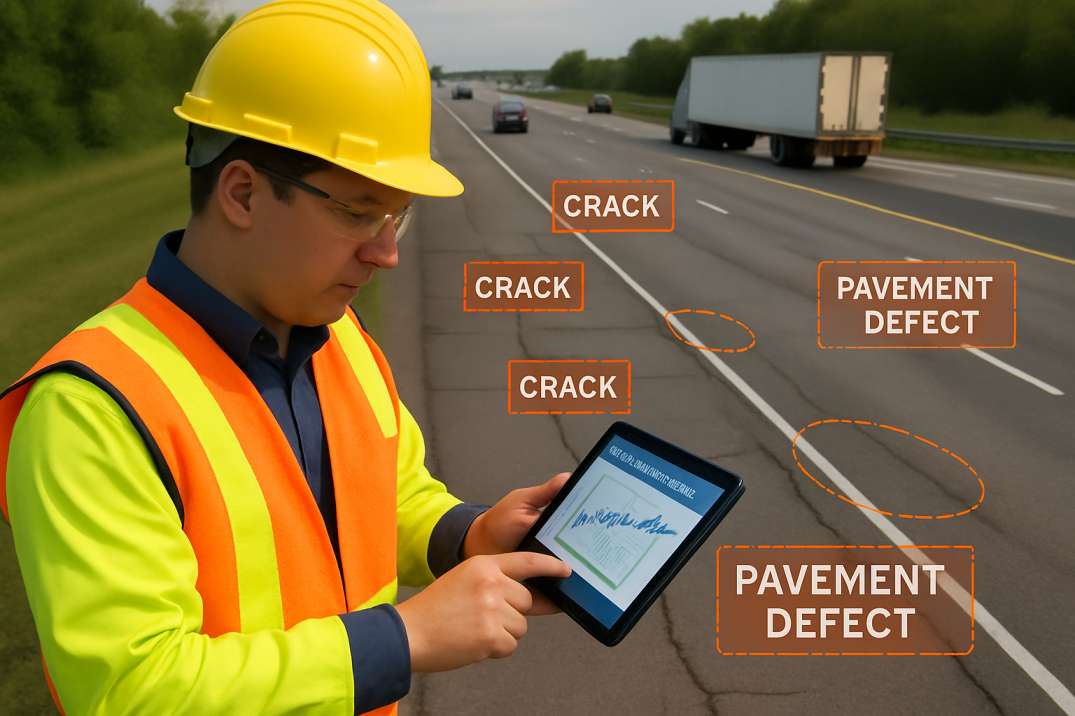Contact Us
RoadVision AI
Private Limited
Office No. 308 & 310, B Block
Ansal Chamber - 1, Bhikaji Cama Place,
Near Engineers India Limited (EIL) Bhawan, New Delhi - 110066
© 2024 | RoadVision AI | All rights reserved
In the rapidly evolving world of road asset management, one of the most critical challenges faced by U.S. highway engineers is predicting when pavement will fail. Traditional approaches are reactive, expensive, and often inaccurate. Today, the integration of AI pavement management systems is fundamentally changing how agencies approach pavement fatigue life prediction. With the backing of FHWA smart pavement initiatives, engineers now have access to real-time data that helps forecast failures long before they occur.
In this blog, we explore how artificial intelligence, coupled with smart sensors and predictive analytics, is enabling accurate, timely, and scalable pavement condition monitoring across the United States.

Pavement fatigue refers to the progressive cracking of road surfaces under repeated traffic loading. These tiny microcracks eventually develop into potholes, rutting, and serious safety hazards.
If not addressed proactively, pavement fatigue leads to:
This makes fatigue life prediction a vital part of any intelligent road asset management strategy.
The Federal Highway Administration (FHWA) is actively promoting smarter infrastructure through projects that integrate real-time sensing and AI analytics into pavement systems. According to the FHWA report you can read here, traditional Falling Weight Deflectometers (FWDs) and manual inspections often fall short in capturing early-stage fatigue.
Instead, technologies like:
are being adopted to support continuous fatigue monitoring, even in harsh climates. This innovation aligns directly with what RoadVision AI is bringing to the table.
At its core, AI pavement management works by ingesting high-resolution data from sensors or mobile inspections and training models to detect patterns that indicate material stress or early fatigue.
Key AI applications include:
By deploying RoadVision’s Pavement Condition Survey tools, agencies can reduce uncertainty, enhance planning accuracy, and lower long-term maintenance costs.
The FHWA study emphasizes the use of self-powered smart sensors embedded into the pavement that communicate wirelessly with roadside nodes. These systems continuously collect data such as:
The data is processed in real time by AI algorithms to evaluate:
These insights allow agencies to act before the road surface begins to visually fail. RoadVision AI enhances this process through AI-powered mobile collection, enabling highway departments to analyze thousands of miles without embedded hardware.
With over 4 million miles of public roads in the United States and increasing climate variability, traditional asset management models are no longer sufficient. Here’s why AI-based fatigue life prediction is becoming a necessity:
With RoadVision’s Road Safety Audit and Road Inventory Inspection solutions, engineers can track, inspect, and preserve infrastructure with unprecedented accuracy.
RoadVision AI helps governments and contractors move from reactive fixes to proactive planning by offering:
Our system is trusted by agencies looking to modernize their networks and make smart infrastructure investments that scale.
Explore how RoadVision’s Traffic Survey and AI-powered case studies are helping authorities across the globe.
The future of U.S. infrastructure depends on smarter maintenance planning. By using AI for pavement fatigue life prediction, agencies are reducing costs, improving safety, and aligning with the FHWA’s digital infrastructure vision.
RoadVision AI is revolutionizing the way we build and maintain infrastructure by leveraging the power of AI in roads to enhance road safety and optimize road management. By utilizing cutting-edge roads AI technology, the platform enables the early detection of potholes, cracks, and other road surface issues, ensuring timely maintenance and improved road conditions.
With a mission to build smarter, safer, and more sustainable roads, RoadVision AI ensures full compliance with both IRC Codes and FHWA (Federal Highway Administration) standards. By aligning with Indian and U.S. roadway regulations, it empowers engineers and stakeholders to make data-driven decisions that reduce costs, minimize risks, and enhance the overall transportation experience.
With RoadVision AI, fatigue failure doesn’t have to catch you by surprise. Predict it, plan for it, and prevent it—before it costs millions.
Want to see it in action? Book a demo with us today and transform how your agency manages roads.
Q1. What is pavement fatigue life prediction?
It’s the process of estimating when a pavement will fail under repeated traffic loads, allowing early intervention to prevent damage.
Q2. How does AI help in pavement condition monitoring?
AI analyzes sensor and inspection data to detect early strain, forecast fatigue, and optimize maintenance schedules.
Q3. Is fatigue life monitoring aligned with FHWA goals?
Yes, FHWA supports the shift toward smart sensors and AI for continuous pavement monitoring, as highlighted in their recent reports.